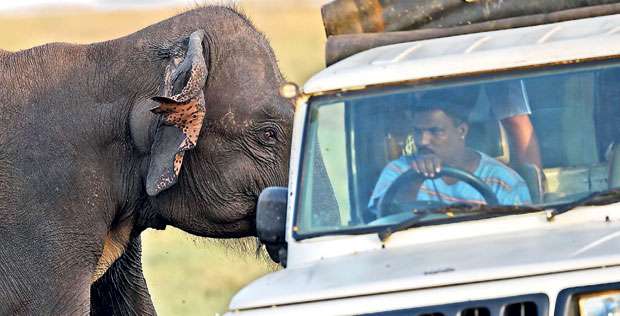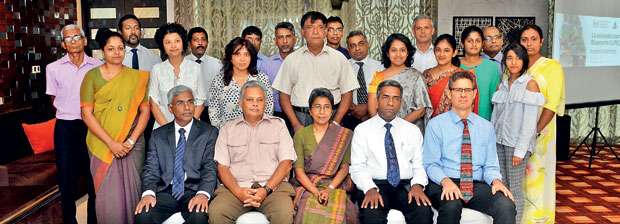16 Jan 2019 - {{hitsCtrl.values.hits}}

 he Human Wildlife Conflict (HWC) prevails largely within the Asian and African regions. Sri Lanka in particular has suffered the loss of 87 human lives from elephant attacks during 2017. The Department of Wildlife Conservation (DWLC) also revealed an estimated 3 million people living under constant threat due to this crisis. To put into perspective the economic burden faced by the poor farmers in these areas, 6320 incidents of property damage were reported during a 5 year period between 2011 and 2015.On the flip side of the conflict, owing to the HWC, the Sri Lankan elephant is now listed as an endangered species. Within 60-75 years a drastic drop of 50% in the number of wild elephants has been witnessed while an average of 230 elephants are killed per year.
he Human Wildlife Conflict (HWC) prevails largely within the Asian and African regions. Sri Lanka in particular has suffered the loss of 87 human lives from elephant attacks during 2017. The Department of Wildlife Conservation (DWLC) also revealed an estimated 3 million people living under constant threat due to this crisis. To put into perspective the economic burden faced by the poor farmers in these areas, 6320 incidents of property damage were reported during a 5 year period between 2011 and 2015.On the flip side of the conflict, owing to the HWC, the Sri Lankan elephant is now listed as an endangered species. Within 60-75 years a drastic drop of 50% in the number of wild elephants has been witnessed while an average of 230 elephants are killed per year.
Attempting to alleviate the threats to both humans and elephants, the International Institute for Environment and Development (IIED), the DWLC, the Institute of Policy Studies of Sri Lanka (IPS), Insurance companies, NGOs and Local Government joined forces to seek a sustainable solution through the LIFE project on January 10, 2019 at Mövenpick Hotel in Colombo 03.
"The underlying cause for HEC is the competition for space between humans and elephants. It’s intensified by growth of the rural population"
The project was introduced by Paul Steele, Chief Economist of the International Institute for Environment and Development (IIED), UK. The project is funded by  Darwin Initiative of the UK’s Department for Environment and Food and Rural Affairs.
Darwin Initiative of the UK’s Department for Environment and Food and Rural Affairs.
The LIFE project aims to “develop and test private, commercial insurance schemes to reduce the impact of HWC on women and men and small farmers in Sri Lanka and Kenya.” Considering that similar ventures faced failure in the past, the LIFE project intends to overcome challenges like: Cost effective verification of insurance, timely and fair payments, payments linked to damage prevention and the financial sustainability of
insurance schemes.
IPS Research Fellow, Athula Senaratne presented a situational analysis of the Human- Elephant Conflict in Sri Lanka. He examined the facts, the causes and the mitigation methods relevant. He pointed out that “according to records, the natural deaths of elephants is less than 10%..and the majority of elephants are dying from gun shots, explosive devices, electrocution, poisoning...”
"According to records, the natural deaths of elephants is less than 10%..and the majority of elephants are dying from gun shots, explosive devices, electrocution, poisoning"
- Athula Senaratne
He highlighted that “the underlying cause for HEC is the competition for space between humans and elephants. It’s intensified by growth of the rural population, expansion of the agricultural sector and large-scale development projects.”
The Chief Guest Chandana Sooriyabandara, the Director General of the DWLC, described the HEC as “the most significant environmental issue at the moment in Sri Lanka.” He touched on the importance of relationships between locals and officials in solving the HEC. He explained that as the law enforcement attempts to stop communal strategies against elephants, they counteract with harsher solutions. “They were using the shooting option at the very beginning. Then they shifted to poisoning and electrocution methods and the latest is ‘hakka patas’. This is due to the strategic approaches by the DWLC against those moves.” Considering all these, he regarded the LIFE project as a way of reducing the intensity of such counteractive measures.
"They were using the shooting option at the very beginning. Then they shifted to poisoning and electrocution methods and the latest is ‘hakka patas"
- Chandana Sooriyabandara
During the technical session, M.S.L.R.P. Marasinghe, the Deputy Director of Law Enforcement at the Department of Wildlife Conservation, presented the interventions for mitigating the HEC in Sri Lanka. He delved into the co-habitation approach, the trends and logistics of insurance and compensation and how to overcome its past failures.
"The organisers also launched a three-year project to pilot private insurance for human wildlife in selected Districts of the North Western and North Central Provinces in Sri Lanka"
IPS Research Economist, Kanchana Wickramasinghe addressed the role of insurance in mitigating the HEC in Sri Lanka. She discussed the different questions that arise when designing an innovative insurance scheme for wild elephant risks; is the risk covariate or idiosyncratic? The probability of risk and scope of loss, and the existence of insurable interest.
As the event continued, different perspectives of the issue were explored, an overview of the issue and the work plans were presented and discussion was promoted among key stakeholders from Government, private sector and civil society. The organisers also launched a three-year project to pilot private insurance for human wildlife in selected Districts of the North Western and North Central Provinces in Sri Lanka. Thus, the first steps of achieving co-existence in a manner that did not threaten either species were taken by this ambitious project.

30 Nov 2024 1 hours ago
30 Nov 2024 4 hours ago
30 Nov 2024 6 hours ago
30 Nov 2024 7 hours ago
29 Nov 2024 29 Nov 2024